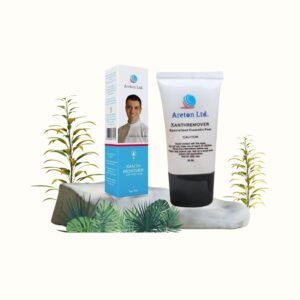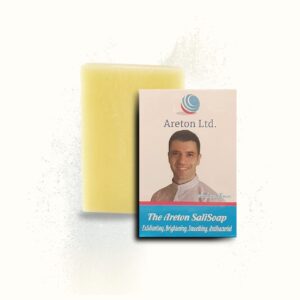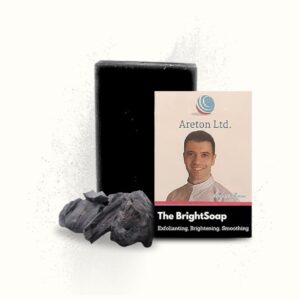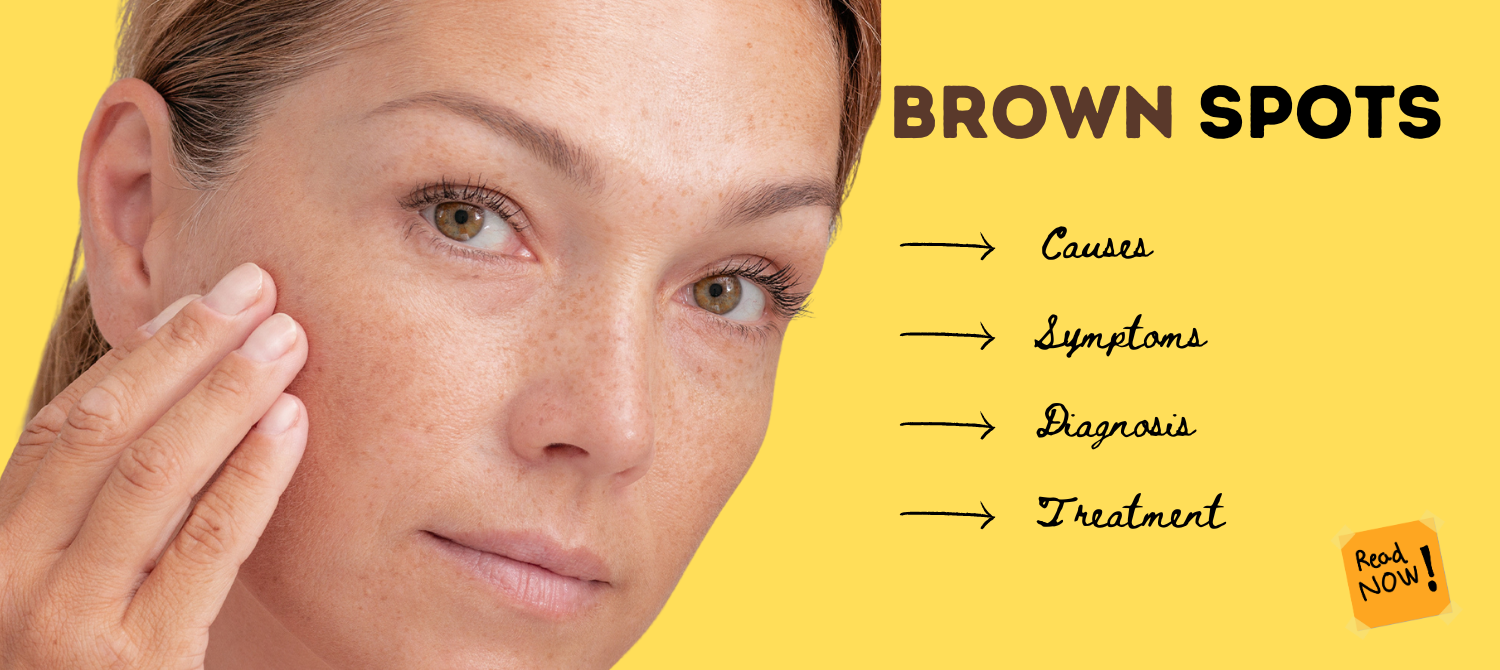What Are Brown Spots In Your Skin?
Brown spots, also known as hyperpigmentation, are a common skin condition that causes patches of skin to become darker than the normal surrounding skin. They can affect people of all skin tones, but are more noticeable on lighter skin.
Brown spots are very prevalent, affecting up to 90% of adults over the age of 50. They can show up at any age, but are more likely to appear as we get older. This is because the production of melanin, the pigment that gives skin its color, slows down as we age. With less melanin in the skin, areas of damage from sun exposure stand out and show up as brown spots.
Types of Brown Spots
Brown spots on the skin can take various forms and have different underlying causes. Some of the most common types of brown spots are:
Freckles
Freckles are small, flat brown spots that are usually tan or light brown in color. They are caused by exposure to sunlight and often appear on the face, shoulders, arms, and hands. Freckles are usually harmless and tend to fade in winter or with less sun exposure. They are more common in people with fair skin.
Age Spots
Age spots, also called liver spots or solar lentigines, are flat brown spots that appear on sun-exposed areas like the face, hands, arms, and neck. They form gradually over time due to cumulative sun exposure and aging. Age spots are very common in adults over age 40. They are not harmful but can sometimes look unsightly.
Sun Spots
Sun spots, known medically as solar lentigines, are flat, brown, irregularly shaped patches of pigmentation that form due to excessive sun exposure. They typically appear on the face, chest, shoulders, and hands. Sun spots tend to multiply and darken over time with ongoing sun damage. They are associated with premature skin aging and skin cancer risk.
Melasma
Melasma causes brown or gray-brown patches, usually on the cheeks, bridge of nose, forehead, chin, and upper lip. It is triggered by fluctuations in hormones and more common in women, especially during pregnancy. Melasma is not harmful but can be upsetting cosmetically. It often improves after pregnancy or with hormone therapy.
Causes of Brown Spots
Brown spots can develop for a variety of reasons. Some of the most common causes include:
Sun Exposure and UV Rays
Excess sun exposure is one of the main causes of brown spots. UV radiation from the sun can damage skin cells and cause pigmentation. Areas of the body that receive the most sun exposure like the face, hands, arms, and chest are most prone to sun-induced brown spots. Using sunscreen regularly can help limit sun damage.
Aging
As skin ages, melanin becomes more clustered. These clusters of melanin appear as spots and patches on the skin. Brown spots due to aging typically show up on the face, chest, hands and arms.
Hormonal Changes
Fluctuations in hormones, especially estrogen, can trigger excess melanin production which leads to brown spots. This is why they frequently appear during pregnancy, menopause or while taking birth control pills.
Genetics
Some people are genetically predisposed to developing brown spots. They often appear in people with fairer skin, and those with a family history of brown spots. People of Asian descent are also at higher risk.
Skin Trauma
Injuries to the skin, like cuts, burns or other trauma can cause brown spots to form. The spots represent accumulated melanin produced to heal damaged skin. They often fade over time.
Symptoms of Brown Spots
Brown spots can appear in various forms on the skin. Some of the most common symptoms and characteristics of brown spots include:
Flat, brown patches on skin – One of the most common symptoms of brown spots is flat discolorations on the skin that are light brown to dark brown in color. They have a flat rather than raised or bumpy texture.
Irregular shapes and borders – Brown spots tend to have irregular, undefined edges and shapes. They can range from round to oval to irregular patches.
Appear on face, hands, shoulders – Areas that are most exposed to sun such as the face, hands, arms, and shoulders are the most common locations for brown spots. They can also appear on the neck, chest, and back.
Varying sizes – Brown spots can range in size from a few millimeters to over a centimeter wide. Some may start small and grow larger over time.
Dry surface texture – The surface of brown spots often appears dry or scaly. They don’t contain oil glands like other parts of the skin.
Appear with aging – Middle age to elderly individuals are more prone to developing brown spots as the skin ages. However, they can occur at any age.
Recognizing the common characteristics of brown spots allows for prompt diagnosis and treatment. Consulting a dermatologist can help determine if any atypical spots require further evaluation.
Diagnosing Brown Spots
A dermatologist will usually diagnose brown spots through a visual exam of your skin. They will look at the size, shape, color and texture of any spots to try to determine what is causing them.
The dermatologist may also ask about your medical history, any medications you are taking, and when the spots first appeared. Providing as much information as possible will help them make an accurate diagnosis.
In some cases, if skin cancer is suspected, the dermatologist may recommend taking a biopsy of the spot. This involves numbing the area with a local anesthetic, then taking a small sample of the skin. The biopsy is sent to a lab to be examined under a microscope by a pathologist.
A biopsy can confirm whether a spot is benign or malignant. It also helps determine the exact type of skin cancer if cancerous cells are found.
Getting an accurate diagnosis through a visual exam and biopsy when necessary is important for proper treatment of brown spots.
Treatment for Brown Spots
There are several treatment options available for brown spots, depending on the severity and type. Some of the most common medical treatments include:
Prescription Creams
Hydroquinone creams are often the first line of treatment. Hydroquinone works by decreasing melanin production, which will lighten the dark patches over time. It is available in strengths up to 4%.
Retinoids like tretinoin also help decrease pigmentation by increasing skin cell turnover. They may be used alone or with hydroquinone.
Corticosteroids may help reduce inflammation and lighten spots when used short-term in combination with other treatments.
Laser Therapy
Lasers work by targeting pigment in the skin and breaking it up. Multiple treatments are usually needed. Q-switched lasers, fractionated lasers, and intense pulsed light (IPL) devices may be used.
Lasers are effective for sun spots and age spots. Possible side effects include redness, swelling, blistering, crusting.
Cryotherapy
Cryotherapy uses liquid nitrogen to freeze and destroy irregular skin cells. It helps lighten spots and even skin tone.
It may be used alone or along with laser therapy. Side effects can include pain, redness, blistering, and scarring if not done properly.
Chemical Peels
Chemical peels use acids like glycolic acid or trichloroacetic acid (TCA) to remove the top layers of skin. This allows new smooth skin to form as the treated skin peels off.
It is effective for improving skin texture and reducing discoloration. Temporary side effects include stinging, redness, irritation, and peeling/flaking.
With treatment, most brown spots can be lightened or removed. Consult a dermatologist to determine the best option based on the type of spots and your skin type.
Home Remedies for Brown Spots
There are several natural home remedies that may help treat brown spots.
Sun Protection and Avoidance
One of the most important things is to minimize sun exposure, which can cause existing spots to darken and new ones to form. Wear sunscreen, protective clothing, and a wide-brimmed hat when outdoors. Avoid going out during peak sun hours.
Over-the-Counter Creams
Using creams containing ingredients like vitamin C, niacinamide, retinol, and kojic acid can help fade spots over time. Look for creams specially formulated for dark spots. Apply them daily as directed.
Natural Oils
Some oils like lemon juice and aloe vera may help lighten brown spots due to their acidic nature. Dilute lemon juice with water, then apply it on the spots and let it sit for 30 minutes before rinsing. Use fresh aloe vera gel directly on spots daily.
Exfoliation
Gently exfoliating with a scrub, loofah, or chemical exfoliant can help remove surface pigmentation and speed up skin cell turnover. Focus on the affected areas a few times per week. Avoid harsh scrubbing which can further irritate skin.
Consistency is key when using home remedies. It may take weeks or months to see results. If a remedy causes irritation, discontinue use. See a dermatologist if spots do not respond to home treatments.
Preventing Brown Spots
Brown spots can often be prevented by practicing good sun protection and skincare habits. Here are some tips for preventing brown spots from forming or getting worse:
Use Sunscreen Daily: Apply broad spectrum sunscreen with an SPF of 30 or higher to all exposed skin every day. Reapply every 2 hours when outdoors. Sun exposure is the main cause of brown spots, so diligent sunscreen use can help prevent more from developing.
Load Up On Antioxidants: Eat a diet rich in antioxidants like vitamins C and E, selenium, and carotenoids. You can also apply antioxidant serums and creams. Antioxidants help neutralize free radicals from UV exposure that cause brown spots.
Moisturize Daily: Keep skin well-moisturized to maintain healthy skin and prevent premature aging. Look for moisturizers with SPF for added sun protection. Dry skin is more prone to sun damage.
Get Annual Skin Checks: See a dermatologist once a year for a full body skin exam. They can check for abnormal moles or growths and catch any brown spots when they first appear so they can be treated early before getting worse.
Following these preventive measures can reduce your risk of developing brown spots or stop existing ones from spreading and darkening further. Check your skin often and see a doctor about any new or changing spots. Consistent skincare and sun safety are key to preventing brown spots.
When to See a Doctor
Brown spots on the skin are usually harmless. However, there are some cases when you should see a doctor for evaluation of brown spots:
If spots change shape, color or texture – Any change in the characteristics of a spot may indicate something more serious like a melanoma. Look out for spots that are growing, bleeding, changing color, or changing shape. These could be signs of skin cancer and require prompt medical evaluation.
If new spots appear rapidly – Many people get sun spots and age spots slowly over time. However, if you notice a sudden outbreak of many new spots, that is not normal. See your doctor to determine the cause and if any treatment is needed.
If spots bleed, itch or crust – Most brown spots are not bothersome and do not cause symptoms. But if a spot becomes itchy, starts bleeding or develops a crusty surface, it could mean there is an infection or more serious issue. Have your doctor examine any spot that is causing worrisome symptoms.
It is important to monitor all spots on a regular basis and be aware of any changes. Seek medical advice promptly if you have any concerns about new, changing or symptomatic spots on your skin. Early evaluation and treatment leads to better outcomes.
Our Brown Spot Treatment
Our proprietary brown spot treatment soap bar is specially formulated to gently fade and minimize the appearance of dark spots and discoloration. Made with natural ingredients like lemon oil, papaya extract, and vitamin C, our soap helps improve skin tone and texture while gently exfoliating to reveal brighter, more even-toned skin over time.
The lemon oil in our soap contains antioxidants that help fade dark spots and discoloration. Papaya extract provides gentle exfoliation to slough off dead skin cells, while also supplying skin-brightening enzymes. Vitamin C evens skin tone while also protecting against UV damage that can worsen spots.
Our brown spot soap is dermatologist recommended for its effective ingredients and gentle formula. With regular use, you’ll notice dark spots start to fade away, revealing the clear, radiant complexion you deserve. The soap has a light, refreshing citrus scent and produces a rich lather that leaves skin feeling soft and smooth.
Fade brown spots naturally with our effective treatment soap. See brighter, more even skin emerge with daily use.
Areton Activated Charcoal Soap Bar: While activated charcoal is known for absorbing impurities, there is little evidence that it specifically targets brown spots. It may help with overall skin clarity by removing dirt and oil, but likely won’t lighten brown spots.
Salicylic Acid Scrub Soap with Kojic Acid, Aloe Vera: This combination has promise for brown spots. Kojic acid is a known skin brightener that helps reduce hyperpigmentation . Salicylic acid is a beta hydroxy acid (BHA) that exfoliates the skin, which can also help fade brown spots . Aloe vera is a soothing ingredient that can help prevent irritation from the kojic acid and salicylic acid.
Salicylic Acid Soap with Kojic Acid, Sulphur: Similar to the previous soap, this combination has kojic acid for brightening and salicylic acid for exfoliation. Sulphur is another ingredient that can help with acne and some types of hyperpigmentation. However, sulphur can also be drying and irritating, so it’s important to do a patch test before using this soap regularly on your face.
Important to Consider:
- Patch test: It’s always recommended to do a patch test on your inner arm before using a new soap on your face. Apply a small amount of the soap to the area and wait 24 hours to see if there’s any redness, itching, or burning.
- Sun protection: Regardless of what soap you use, it’s important to wear sunscreen daily to prevent new brown spots from forming. Sun exposure can worsen hyperpigmentation.
- Consult a dermatologist: If you have concerns about brown spots, especially if they are large, numerous, or changing in appearance, it’s best to see a dermatologist. They can help you determine the cause of your brown spots and recommend the best course of treatment.
Incorporating these points into your response can make it more informative and helpful for people with brown spots who are considering using your soaps.
 Rated 0 out of 5¡A la Venta!Add to basket
Rated 0 out of 5¡A la Venta!Add to basket$50.99Original price was: $50.99.$39.99Current price is: $39.99. Rated 0 out of 5¡A la Venta!Add to basket
Rated 0 out of 5¡A la Venta!Add to basket$10.00Original price was: $10.00.$5.99Current price is: $5.99. Rated 0 out of 5¡A la Venta!Add to basket
Rated 0 out of 5¡A la Venta!Add to basket$10.00Original price was: $10.00.$5.99Current price is: $5.99. Rated 0 out of 5¡A la Venta!Add to basket
Rated 0 out of 5¡A la Venta!Add to basket$10.00Original price was: $10.00.$5.99Current price is: $5.99.


